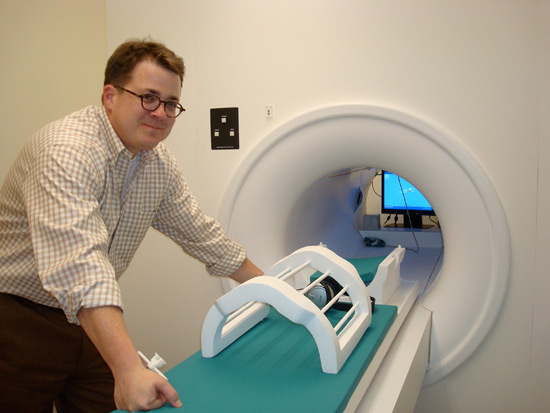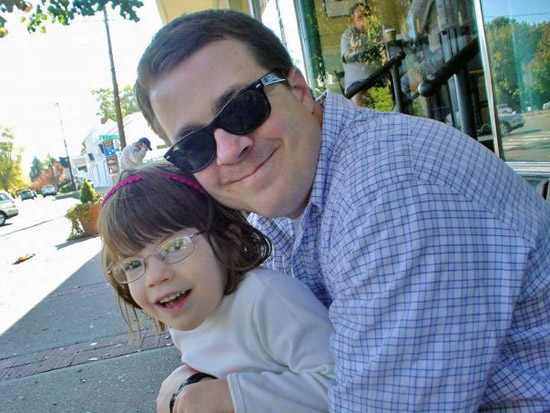THIS ARTICLE IS MORE THAN FIVE YEARS OLD
This article is more than five years old. Autism research — and science in general — is constantly evolving, so older articles may contain information or theories that have been reevaluated since their original publication date.

Changing course: Colleagues say Kevin Pelphrey’s work on children with autism is set to undo many of the misconceptions in the field.
Sam, all of 12 years old, is climbing into a large magnetic resonance imaging (MRI) machine at Yale-New Haven Hospital. The fluorescent white scanner, a cross between an alien spacecraft and a coffin, no doubt sends chills down the spines of most of those who are rolled, flat on their backs, into it.
Not Sam. He doesn’t seem the least bit bothered by the whirrs and clicks, the earplugs, helmet or any other aspect of the confined space. That’s remarkable enough because, like most children his age, Sam is loud and rambunctious. But he also has autism.
Children with autism often react poorly to loud sounds, bright lights or touch — major obstacles for researchers who want to scan their brains. But engaging these kids is the specialty of Kevin Pelphrey, the scientist who is studying children like Sam.
With robust training in developmental psychology and a techie’s fervor for new tools, Pelphrey is systematically investigating how the brain changes during development — starting in infants as young as 6 weeks old.
This long-term approach should also reveal when things go off track in autism. Pelphrey is scanning about 110 children, including Sam, who are participants in the Simons Simplex Collection, a repository of genetic, brain and behavioral data from 2,000 families of children with autism.
Pelphrey has a strategy for working with young children like Sam: he and his team turn the whole process into a game. Sam first simulated the MRI experience on a miniature mock scanner. Two energetic research assistants taught him to play “the statue game,” the object of which was to keep his head absolutely still. He learned to watch a movie (Milo & Otis) through mirrors attached to his ‘Power Ranger helmet.’ He seemed to have a good time, shrieking, “Three, two, one, blast out!” as he rolled out of the tunnel.
Now, in the real scanner, Sam is performing tasks designed to measure the way his mind reacts to other people’s actions. In one, he plays a ball-tossing game with virtual players. In some trials, Sam’s playmates toss him the ball; in others, they ignore him. All the while, Pelphrey watches intently from the other side of a glass wall, sitting next to a large monitor showing Sam’s brain activity.
Pelphrey, 35, has a lot of experience with autism, and not just because of the dozens of affected children who have come to see him at the Yale Child Study Center. In 2007, his then 3-year-old daughter, Frances, was diagnosed with the disorder. In short order, understanding autism became the focus of Pelphrey’s household — and his research. Late last year, his then 16-month-old son, Lowell, was also placed on the autism spectrum.
“The argument has been made that there are many autisms. I think that’s an overstatement,” Pelphrey says. His hunch — which he outlines in an upcoming review — is that thousands of different genetic causes could all lead to the same disruptions in the ‘social brain,’ the network of circuits that allows us to recognize emotions, communicate with others and understand their thoughts and desires.
Most imaging studies in autism have looked at adults or adolescents, making it impossible to know whether any observed patterns are a cause or consequence of the disorder.
In contrast, “[Pelphrey’s] greatest contribution is going to be the ontogeny of the social brain in the first year of life,” notes Ami Klin, director of the autism program at the Yale Child Study Center. “I think he’s going to undo a lot of the misconceptions in the field that resulted from work on adults.”
Unique skill set:

Family ties: Pelphrey has personal experience with autism; in 2007, his then 3-year-old daughter, Frances, was diagnosed with the disorder.
Pelphrey’s experiments date back to his graduate work on infant development in Steve Reznick‘s lab at the University of North Carolina at Chapel Hill. For his dissertation, Pelphrey designed a custom eye-tracking system to probe working memory during the first year of life1.
“Kevin liked to figure out how things worked. If anything in the lab was broken, Kevin would be tinkering with it to make it work better,” Reznick recalls.
Pelphrey’s eye-tracker caught the attention of Joseph Piven, director of the University of North Carolina’s autism research program. Piven, who had done some of the first brain imaging studies on adults with autism, convinced Pelphrey to try an eye-tracking experiment on this group.
The duo found that unlike healthy controls of any age — including 7-week old infants — who focus on the eyes, nose and mouth of a face, men with autism look mostly at the cheeks, chin and forehead2.
Pelphrey then became interested in merging the theoretical approaches of child development with the powerful imaging techniques of cognitive neuroscience. But he knew little about brain anatomy.
Around that time, he met Gregory McCarthy, head of the brain imaging center at Duke University, and approached him about a postdoctoral fellowship.
According to Pelphrey, McCarthy first asked him, “Do you know anything about the brain?” Pelphrey sheepishly said no.
Then McCarthy said, “Well, do you know anything about computers?” Pelphrey replied that he was a programming expert. That sealed the deal.
Within two years, he had acquired what was then a unique skill-set: a solid training in child development, paired with technical knowledge of functional MRI. “That was — that is — pretty rare. I think it gave him a unique perspective to bring to the autism field,” Piven says.
Pelphrey became fascinated by one region in particular: the superior temporal sulcus (STS), the narrow ridge that sits atop the temporal lobe. Neuroscientists had long known that the region becomes active when people look at others’ eye movements. McCarthy and Pelphrey’s experiments filled in much more detail, finding that the area is sensitive to a wide variety of ‘biological motions,’ including humans walking3 and hand and mouth movements4.
“Then we starting wondering: is it just a dumb biological motion detector, or can this region actually tell when someone meant to do something versus when they did it by accident?” Pelphrey says.
To find out, Pelphrey set up a clever experiment in which participants watched a cartoon man looking intently at a blinking dial. In some trials, the man reached for the dial; in others, he reached away from it. Pelphrey found that the STS became more active when the man reached away, indicating that the region is sensitive to another person’s intentions5.
Pelphrey also investigated activity in the region in individuals with autism. He found that, in contrast to healthy controls, those with autism show no difference in activity when watching cartoon people looking in expected or unexpected directions6.
Big moves:
Pelphrey’s prolific publications garnered a lot of attention among cognitive scientists, and his career advanced quickly. In 2007, after serving as an assistant professor at both the University of North Carolina and Duke, he joined the psychology department at Carnegie Mellon University in Pittsburgh.
Carnegie Mellon has a prestigious psychology department, but most of its faculty has a theoretical, rather than patient-based, approach. “I was an oddball,” Pelphrey says. “I needed a child-friendly lab, and parking spots for parents. The place just wasn’t set up for that.”
Then, just a few days after Frances was diagnosed with autism, Pelphrey got a life-changing phone call from Klin, who offered him a job as director of the Yale Child Neuroscience Laboratory.
“The first call I made was to Kevin — there was no question that he was the right person,” Klin says. Klin’s own research dovetails Pelphrey’s: in 2002, he published an eye-tracking study of how individuals with autism look at faces7 just one month after Pelphrey and Piven published theirs.
Since October 2008, when Pelphrey and his family moved to Connecticut, his work and home life have intersected even more than before. All three of his children — Frances, now 6, Kenneth, 4, and Lowell, 2 — are part of the Simons Simplex Collection. Pelphrey says he is “absolutely floored” by some preliminary data from the healthy siblings he has scanned from the collection.
When children with autism and their healthy siblings see displays of biological motion, such as a person playing patty-cake, both groups show abnormally low activity in several brain areas, such as the fusiform gyrus and the ventrolateral prefrontal cortex, both of which are activated during face processing.
In another region, the right posterior STS, healthy siblings show abnormally high activity compared with either their affected siblings or healthy controls.
“With a 10-minute scan, we can completely separate the three groups,” Pelphrey says. These patterns are statistically reliable, so that if a random scan is fed into a computer program, it can predict with high accuracy what group it belongs to, he adds. The work is not yet published.
Pelphrey’s personal experience has led him to study another aspect of autism: emotion regulation. When he first tried to enlist Frances in his experiments, “It was meltdown after meltdown,” he recalls.
Emotional outbursts are common in children with autism but because they are not part of the diagnostic criteria, they typically don’t get much attention from scientists. To test children’s reactions to emotional ups and downs, Pelphrey is scanning their brains while they play games that they’re rigged to lose — such as Sam’s ball-tossing game.
He’s also investigating genetic factors that may be involved by analyzing common variants in several genes, such as the receptors of oxytocin and vasopressin — hormones that have been linked to autism — and one piece of the serotonin transporter, 5-HTTLPR, that is required for the development of social regions in the brain and has long been associated with autism.
If it turns out that certain combinations of variants lead to specific brain patterns or behaviors, it could have a big impact on treatment options for the disorder, Pelphrey says. For instance, some children might benefit from selective serotonin reuptake inhibitors, common antidepressant medications.
“I really like the idea of brain science fueling intervention research,” he says. “If you know something about how genes affect the brain, you can begin to tailor treatments very specifically.”
Cite this article: https://doi.org/10.53053/QBGU2916
By joining the discussion, you agree to our privacy policy.